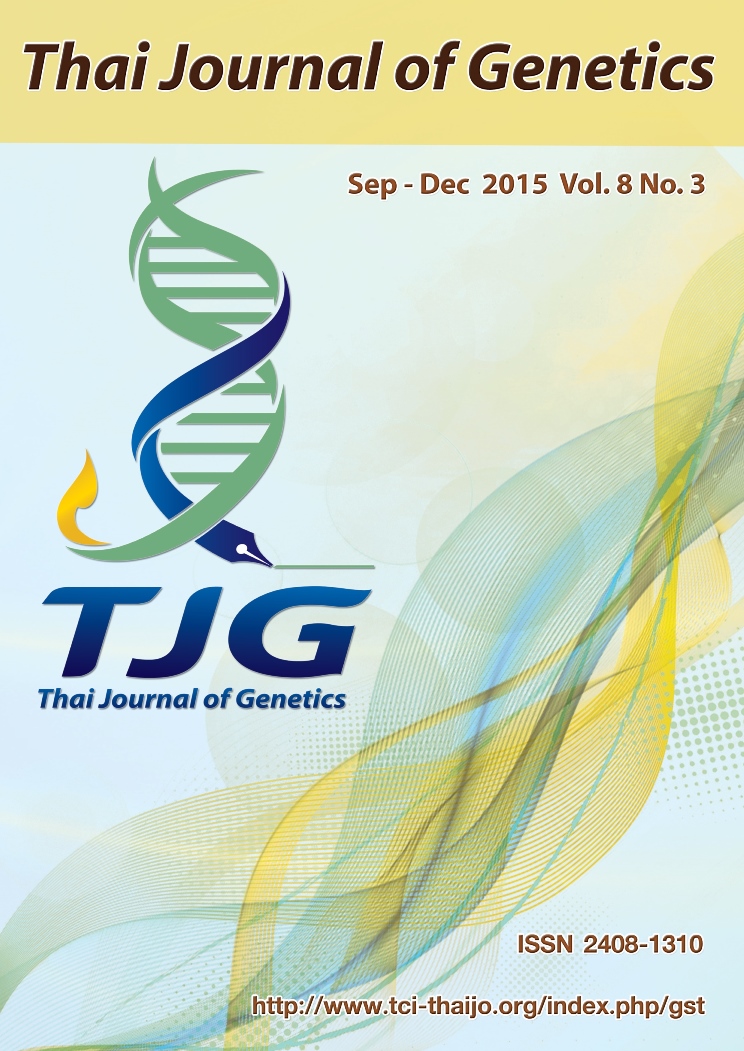เมทิลจัสโมเนทและการทำให้เกิดแผลกระตุ้นการแสดงออกของยีน sesquiterpene synthase ในเนื้อเยื่อเพาะเลี้ยงพลู (Methyl jasmonate and wounding upregulated Sesquiterpene synthase in Piper betle Linn. tissue culture)
Keywords:
พลู (Piper betleLinn.), เซสควิเทอร์ปีน (sesquiterpene), sesquiterpenesynthase, การทำให้เกิดแผ (wounding), เมทิลจัสโมเนท (methyl jasmonate)Abstract
Piper betle Linn. (familyPiperaceae) producesvarieties of sesquiterpenevolatilecompoundsthat have valuable pharmacological activities. Unfortunately, the active compounds are in low amount in plants and their chemically production is still difficult. These make them insufficientusage. Biotechnology is the better choice for promotion of the compounds production. Hence, in this report, the inducers of sesquiterpenesynthase(STS), the key enzyme of the sesquiterpene biosynthesis, were evaluated.Methyljasmonateatvarious concentration and time including 100, 200 and 300 µM was sprayed for 6 12 and 24 hr. and mechanical wounding was appliedon ten-week-old P.betle tissue culture. Afterwards, the STStranscript was investigated by Realtime-qPCR technique. The results showed that the highest upregulation of STS was detected after 100 µMMeJAfor 12 hr. application. Furthermore, wounding alsoinducedSTSexpression. In conclusion, there was probability that P.betle responded to environmental stress through methyljasmonate and sesquiterpeneproduction via sesquiterpenesynthase activation.
บทคัดย่อ
สารเซสควิเทอร์ปีนเป็นสารอินทรีย์ระเหยง่ายที่พบได้ในพลู ถึงแม้ว่าสารในกลุ่มนี้มีฤทธิ์ทางชีวภาพหลากหลายแต่การใช้ประโยชน์จากสารยังคงมีอยู่จำกัด เนื่องจากโครงสร้างโมเลกุลของสารซับซ้อน ทำให้การสังเคราะห์โดยขบวนการทางเคมีทำได้ยาก นอกเหนือจากนั้นพืชเองก็สังเคราะห์ได้ไม่เพียงพอ การใช้เทคโนโลยีทางชีวภาพเข้ามาช่วย จึงเป็นทางเลือกสำหรับการเพิ่มการผลิตสารกลุ่มนี้ได้ งานวิจัยนี้จึงได้ทำการศึกษาหาปัจจัยกระตุ้นการแสดงออกของยีน sesquiterpene synthase (STS) ซึ่งเป็นเอนไซม์หลักในวิถีสังเคราะห์สารเซสควิเทอร์ปีนในเนื้อเยื่อเพาะเลี้ยงพลู โดยฉีดพ่นเนื้อเยื่อเพาะเลี้ยงพลูอายุ 10 สัปดาห์ ด้วยสารเมทิลจัสโมเนท
ซาลิไซเลท ไคโตซาน เซลลูเลส และการทำให้เกิดบาดแผลบนใบ หลังจากนั้นทำการวัดระดับทรานสคริปของ STS ด้วยวิธี reverse transcription PCR (RT-PCR) และ real-time quantitative PCR (RT-qPCR) พบว่าระดับทรานสคริปของ STS สูงที่สุด เมื่อพลูได้รับ MeJA 100 µM เป็นเวลา 12 ชั่วโมง นอกเหนือจากนั้นการทำให้เกิดบาดแผลมีผลกระตุ้นการแสดงออกของยีน STS ด้วย การค้นพบนี้แสดงให้เห็นถึงกลไกที่พลูใช้ตอบสนองต่อสภาวะเครียดจากสิ่งแวดล้อม โดยการส่งสัญญาณผ่านเมทิลจัสโมเนทและการเพิ่มการสร้างสารเซสควิเทอร์ปีนด้วยการกระตุ้นเอนไซม์ sesquiterpene synthase ความรู้ที่ได้จะเป็นประโยชน์ต่อการพัฒนาวิธีการเพื่อเพิ่มการผลิตสารเซสควิเทอร์ปีนเพื่อนำไปประยุกต์ใช้ต่อไป
References
Cheng AX, Xiang CY, Li JX, Yang CQ, Hu WL, Wang LJ, Lou YJ, Chen XY (2007) The rice (E)-β-caryophyllene synthase (OsTPS3) accounts for the major inducible volatile sesquiterpenes. Phytochemistry 68:1632–41.
Choopayak C, Laksuk H, KongbangkerdA (2010) Volatile compounds from Piper betleLinn. Sample collected from Phitsanulok Thailand by SPME method. 6thNaresuan ResearchConference.Phitsanulok, Thailand.
Kollner TG, Held M, Lenk C, Hiltpold I, Turlings TCJ, Gershenzon J (2008) A Maize (E)-{beta}- Caryophyllene Synthase Implicated in Indirect Defense Responses against Herbivores Is Not Expressed in Most American Maize Varieties. Plant Cell20:482–94.
Miller B, Madilao L, Ralph S, Bohlmann J (2005) Insect-Induced Conifer Defense. White Pine Weevil andMethyl Jasmonate Induce Traumatic Resinosis, de NovoFormed Volatile Emissions, and Accumulation ofTerpenoid Synthase and Putative OctadecanoidPathway Transcripts in Sitka Spruce. Plant Physiol 137: 369–82.
Taniguchi S, Miyoshi S, Tamaoki D, Yamada S, Tanaka K, Uji Y, Tanaka S, Akimitsu K, Gomi K. (2014) Isolation of jasmonate-induced sesquiterpene synthase of rice: Product of which has an antifungal activity against Magnaportheoryzae. J Plant Physiol 7171:625–32
Wang R, Peng S, Zeng R, Ding L, Wen L, Xu Z(2009) Cloning, expression and wounding induction ofβ-caryophyllene synthase gene from Mikaniamicrantha H.B.K. and allelopathic potential of bcaryophyllene. Allelopathy J 24:35–44.


